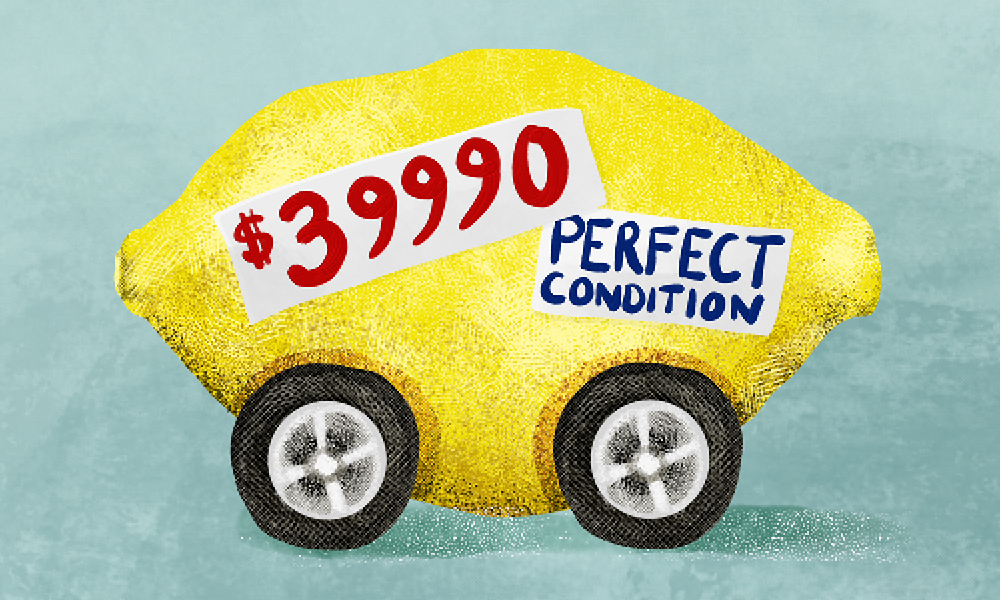On 1 September 2019, the Attorney-General and Minister for Justice, Yvette D’Ath, issued a press release entitled ‘New “Lemon Laws” put squeeze on dodgy car dealers’.
The Attorney-General’s use of the term ‘lemon laws’ was a reference to the commencement of the Queensland Civil and Administrative Tribunal and Other Legislation Amendment Act 2019 (Qld). In more prosaic terms, the amendments:
- increased the Queensland Civil and Administrative Tribunal’s jurisdictional limit for motor vehicle disputes from $25,000 to $100,000
- reinstated the statutory warranty in respect of older vehicles.
The amendments have been in operation for more than a year and there is now a sufficient body of cases decided under the amendments such that it is useful to make some practical observations about their operation.
For the purposes of brevity, I will confine my observations to claims between $25,000 and $100,000 made under the Australian Consumer Law (ACL).
Claims under the Australian Consumer Law
Section 50A of the Fair Trading Act 1989 (Qld) vests the Queensland Civil and Administrative Tribunal (the tribunal) with jurisdiction in respect of certain actions under the ACL. These include:
- actions for damages under s236(1) of the ACL for a contravention of Chapter 2 or 3,1 and
- actions against a supplier or manufacturer for a failure to comply with the statutory guarantees in Part 3.2 of the ACL.2
The claims must relate to “motor vehicles”3 and seek relief of no more than $100,000.
It is important to note that the protections against misleading or deceptive conduct, and most (but not all) of the consumer guarantees, apply only when the goods or services are supplied to a consumer in “trade or commerce”. In Hilton v Baartz,4the tribunal held that the private sale of a motor vehicle through a classified advertisement on Gumtree was not in trade or commerce.
Most of the claims lodged with the tribunal since 1 September 2019 have related to the guarantee of acceptable quality contained in s54 of the ACL, which will be the focus of this article.
Acceptable quality
Acceptable quality is defined in the ACL by reference to a reasonable consumer. Section 54(2) sets out the attributes of goods relevant to assessing acceptable quality:
Goods are of acceptable quality if they are as:
- fit for all the purposes for which goods of that kind are commonly supplied
- acceptable in appearance and finish
- free from defects
- safe
- durable
as a reasonable consumer fully acquainted with the state and condition of the goods (including any hidden defects in the goods) would regard as acceptable having regard to the matters in s54(3).
The factors in s54(3) which should be considered in assessing acceptable quality are:
- the nature of the goods
- the price of the goods (if relevant)
- any statements made about the goods on any packaging or label on the goods
- any representation made about the goods by the supplier or manufacturer of the goods
- any other relevant circumstances relating to the supply of the goods
In practice, the bar set by s54 is a low one. There are very few defects that a reasonable consumer would regard as acceptable in purchasing a vehicle worth over $25,000. Particularly in the case of a new vehicle with a multi-year warranty, the vehicle will not be durable if it does not last or endure in a reasonable condition for a reasonable time.
The more vexing issue is usually assessing whether the vehicle failed to be of acceptable quality at the time of supply.5 The tribunal has been prepared to infer that latent defects were present at the time of supply where they manifested themselves shortly after the vehicle was supplied. Examples of this include Haisman v Drive (Aust) Pty Ltd,6 ACH Computing Pty Ltd v Austral Pty Ltd trading as Brisbane City Jaguar Land Rover,7 Foley v Westco Cairns Pty Ltd8 and Kablar Financial Services Pty Ltd v LSH Auto (Brisbane) Pty Ltd trading as Mercedes-Benz Brisbane.9 These cases are discussed further below.
However, it is more difficult to make this inference when the vehicle is a used vehicle, and where a substantial period of time has elapsed between the time of supply and the manifestation of the defect. For example, in Bevis v Mercedes Benz Australia/Pacific Pty Ltd & Anor,10 the problems with the engine going into limp mode did not manifest themselves until over three years after the date of supply, and at a time when the vehicle had travelled over 100,000 km. The tribunal observed that the more time that has elapsed, and the further a vehicle has been driven, the greater is the scope for any defects to have arisen from intervening events occurring after the time of supply.
Remedies
Refund
The remedy sought in most of the claims lodged with the tribunal is a refund. A consumer may reject the goods and choose a refund or replacement under s259(3)(a) of the ACL in the event of a “major failure”.11
Section 260 of the ACL defines a major failure to mean:
- the goods would not have been acquired by a reasonable consumer fully acquainted with the nature and extent of the failure, or
- the goods depart in one or more significant respects from their description or model, or
- the goods are substantially unfit for a purpose for which goods of the same kind are commonly supplied and they cannot, easily and within a reasonable time, be remedied to make them fit for such a purpose, or
- the goods are unfit for a disclosed purpose and they cannot, easily and within a reasonable time, be remedied to make them fit for such a purpose, or
- the goods are not of acceptable quality because they are unsafe.
The tribunal has accepted that an accumulation of individually minor defects can be aggregated to amount to a major failure.12
It is fair to say that the more defects a vehicle has, and the more time it has spent off the road as a result of those defects, the more likely the tribunal is to find that there is to be a major failure. Examples of where the tribunal has found the existence of a major failure include:
- Haisman v Drive (Aust) Pty Ltd,13 where the presence of defects resulted in the motor vehicle being returned to the dealer for 30 days out of the first two months of the applicant’s ownership of the motor vehicle
- ACH Computing Pty Ltd v Austral Pty Ltd trading as Brisbane City Jaguar Land Rover,14 where the presence of defects resulted in the vehicle being returned to the dealer for 29 days out of the first few months of the applicant’s ownership of the motor vehicle
- Foley v Westco Cairns Pty Ltd,15 where the presence of defects resulted in the vehicle being returned to the dealer on 14 occasions, and remaining in the dealer’s possession for 57 days in the first year of the applicant’s ownership of the vehicle and 16 days in the second year
- Kablar Financial Services Pty Ltd v LSH Auto (Brisbane) Pty Ltd trading as Mercedes-Benz Brisbane,16 where the presence of defects which resulted in the vehicle being returned on nine occasions in the first year of the applicant’s ownership.
For completeness, a consumer may reject the goods under s259(2)(b)(ii) of the ACL even in the absence of a major failure, if the supplier does not remedy the failure within a reasonable time. This is what occurred in Groves v Sunshine State Recreational Vehicles Pty Ltd trading as Sunshine State RV,17 where the failure was not remedied within the timeframe agreed by the supplier.
In order to obtain a refund, the consumer is required to reject the goods within the “rejection period”.
Section 262(2) of the ACL provides that the rejection period is the period within which it would be reasonable to expect the relevant failure of the guarantee to become apparent having regard to:
- the type of goods
- the use to which a consumer is likely to put them
- the length of time for which it is reasonable for them to be used, and
- the amount of use to which it is reasonable for them to be put before such a failure becomes apparent.
As a general observation, most applicants do not delay in requesting a refund, often doing so repeatedly. However, there is the occasional case in which there is an inexplicable delay. For example, in Cox v J & M Phelan trading as Carrara Carmart,18 the first time the applicant requested a refund was in the application itself filed in the tribunal. The application was filed more than five months after the failure had become apparent. In those circumstances, the tribunal was not satisfied that the rejection took place within the rejection period.
Damages
The consumer can also recover damages for any loss or damage suffered because of the failure of the goods to comply with the guarantee provided the loss was reasonably foreseeable under s259(4).
I note that even where there is a major failure, the applicant may elect to keep the vehicle and claim damages for its repair under s259(4), rather than being limited to rejecting the goods and seeking a refund.19
However, there are important limitations on the damages available under s259(4). In Vautin v BY Winddown, Inc (formerly Bertram Yachts) (No.4),20 Derrington J stated:
“It would appear that this subsection is concerned with the recovery of ‘reliance losses’ as the inclusion of the limitation of ‘reasonable foreseeability’ pertains to such losses rather than expectation losses.”
The exclusion of expectation losses meant that tribunal was unable to entertain a claim for loss of income in Cox v J & M Phelan trading as Carrara Carmart,21 or a claim for loss of interest on the funds used to purchase the motor vehicle in Groves v Sunshine State Recreational Vehicles Pty Ltd trading as Sunshine State RV.22
In Pojzak v Congeo Nominees Pty Ltd,23 the Victorian Civil and Administrative Tribunal stated that “any entitlement to claim damages comes with the obligation to mitigate the damages”. The requirement that an applicant mitigate his or her losses has been considered by the tribunal in the following cases:
- In Hammond v Nissan Motor Co (Australia) Pty Ltd,24 the evidence was that the costs of returning the vehicle to service were approximately $2200. In these circumstances, the tribunal considered it appropriate to limit the damages sought to $2200, as the applicant could have returned the vehicle to service and mitigated his damages to this amount.
- In Vale v Motorworld QLD Pty Ltd,25 the applicant refused requests by the dealer to leave the vehicle to enable further investigations to be undertaken. Had the applicant given the dealer adequate time to diagnose the problem, the costs incurred by the applicant could potentially have been avoided. In those circumstances, the tribunal did not consider that the applicant was entitled to damages for repairs to the motor vehicle.
- In Cox v J & M Phelan trading as Carrara Carmart,26 the applicant did not ask the dealer to either repair or arrange repairs to the vehicle. In these circumstances, the tribunal did not consider that the applicant was entitled to damages for the registration costs of the vehicle.
Claims against manufacturers
The remedies available to a consumer against the manufacturer of goods are set out in ss271 and 272 of the ACL. Relevantly, those remedies do not include a refund.
Nevertheless, applicants regularly seek refunds from manufacturers. It is not immediately obvious why this is so. In Hammond v Nissan Motor Co (Australia) Pty Ltd,27 the applicant was notified by the respondent at an early stage that the remedy sought was not available against the manufacturer, and it was suggested that he join the supplier. The applicant refused to heed this advice, and was substantially unsuccessful in the proceedings.
On the other hand, it is more readily apparent why a supplier might wish to join the manufacturer as an additional respondent. Under s274(2) of the ACL, a manufacturer is liable to indemnify a supplier in respect of a failure under s54. A supplier might also perceive there is a forensic advantage to be gained from having the manufacturer as an additional party to the proceedings.
In Knox v Tait Motors Pty Ltd t/as Tait Auto Group,28 the tribunal found that it was inevitable that the joinder of the manufacturer would add to the length and complexity of the proceeding and the hearing, and in turn delay any remedy which might ultimately found to be available to the applicant. The approach taken by the tribunal has been that it is open to a supplier to commence separate proceedings against the manufacturer in respect of its cause of action for indemnity in the event that proves necessary. No such proceedings had been commenced as at the time of writing.
Conclusion
It is apparent that the use of the term ‘lemon laws’ to describe the 1 September 2019 amendments is largely a misnomer. The amendments, for the most part, are confined to increasing the tribunal’s jurisdiction from $25,000 to $100,000 in relation to existing provisions of the ACL. Previously, these claims had to be brought in the courts.
Nevertheless, the increase of the tribunal’s jurisdiction has provided consumers and suppliers with a forum to resolve their disputes without the formality and costs of proceedings in the courts. It seems to me that this advance, in itself, represents a significant improvement on the state of the law as it existed prior to 1 September 2019.
Glen Cranwell is a full-time member of the Queensland Civil and Administrative Tribunal, and is the list manager of the Motor Vehicle List. The views expressed are those of the author, and not those of the tribunal. (Article last updated 15.06.22)
Footnotes
1 For example, s18 (misleading or deceptive conduct) and s20 (unconscionable conduct).
2 See s259(2),(3) and (4); s265(3); s267(2), (3) and (4); s269(3); s271(1), (3) and (5); s274(3); s279(1).
3 Motor vehicle is defined in s12(1) of the Motor Dealers and Chattel Auctioneers Act 2014 (Qld).
4 [2019] QCAT 362.
5 See Medtel Pty Ltd v Courtney (2003) 130 FCR 182, [64] and [70].
6 [2020] QCAT 44.
7 [2020] QCAT 176.
8 [2020] QCAT 455.
9 [2020] QCAT 346.
10 [2020] QCAT 421.
11 On the tribunal’s jurisdiction to order a refund, see In Haisman v Drive (Aust) Pty Ltd [2020] QCAT 44, [21]-[24].
12 See Cary Boyd v Agrison Pty Ltd [2014] VMC 23, [51].
13 [2020] QCAT 44.
14 [2020] QCAT 176.
15 [2020] QCAT 345.
16 [2020] QCAT 346.
17 [2020] QCAT 157.
18 [2020] QCAT 190, [26].
19 Lieven v Shem-mell Pty Ltd trading as Capalaba Car World [2020] QCAT 209.
20 [2018] FCA 426, [294].
21 [2020] QCAT 190, [32].
22 [2020] QCAT 157, [29].
23 [2013] VCAT 217, [80].
24 [2020] QCAT 302, [29].
25 [2020] QCAT 232, [29].
26 [2020] QCAT 190, [34].
27 [2020] QCAT 302.
28 [2019] QCAT 351.








Share this article